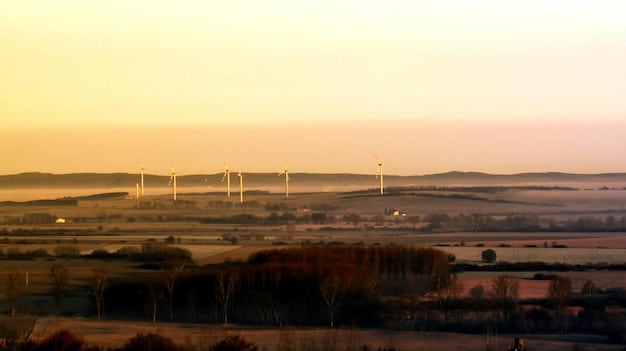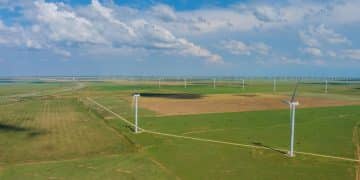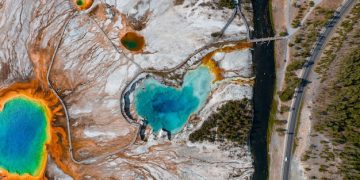Renewable Energy Transition: US Grid Challenges in 2025

The renewable energy transition presents significant challenges for the US grid in 2025, including integrating intermittent renewable sources, upgrading aging infrastructure, ensuring grid resilience, managing energy storage, and addressing policy and regulatory barriers.
The urgency of climate change has accelerated the push for a **renewable energy transition**, but integrating these sources into the US grid presents a complex set of challenges for 2025.
Understanding the Renewable Energy Transition
The renewable energy transition involves shifting from fossil fuels to sustainable energy sources like solar, wind, hydro, and geothermal. This transition is crucial for reducing greenhouse gas emissions and mitigating the impacts of climate change. However, it’s not as simple as just building more solar panels and wind turbines. The existing US grid infrastructure, designed primarily for centralized fossil fuel-based power plants, faces numerous challenges in accommodating these new, distributed, and variable energy sources.
Several factors are driving this transition, including declining costs of renewable energy technologies, increasing consumer demand for clean energy, and government policies aimed at promoting renewable energy adoption.
Key Drivers of the Renewable Energy Transition:
- Environmental Concerns: Growing awareness of climate change impacts.
- Economic Benefits: Decreasing costs of renewable technologies.
- Policy Support: Government incentives and mandates.

The challenges facing the US grid include technical, economic, and regulatory hurdles that must be addressed to ensure a smooth and reliable transition.
In conclusion, the shift to renewable energy is propelled by environmental, economic, and policy factors, but its realization depends on addressing the multifaceted challenges confronting the US grid.
Intermittency of Renewable Energy Sources
One of the most significant challenges is the intermittency of renewable energy sources like solar and wind. Unlike traditional power plants that can operate continuously, solar and wind power depend on weather conditions. This variability can lead to fluctuations in electricity supply, potentially causing instability on the grid.
Managing this intermittency requires sophisticated forecasting tools and strategies to balance supply and demand. Energy storage solutions, such as batteries and pumped hydro storage, are crucial for storing excess renewable energy during peak production periods and releasing it when demand is high or when renewable sources are unavailable.
Strategies for Managing Intermittency:
- Advanced Forecasting: Improving weather prediction models.
- Energy Storage: Deploying battery and pumped hydro storage systems.
- Demand Response: Encouraging consumers to shift energy usage.
Furthermore, grid operators need to coordinate the dispatch of different generation sources to ensure a stable and reliable electricity supply. This requires advanced control systems and communication infrastructure to monitor and manage the grid in real-time.
To summarize, intermittency is a primary challenge in renewable energy integration, necessitating advanced forecasting, energy storage solutions, and optimized grid management to maintain stability.
Aging Infrastructure and Grid Modernization
The US grid is aging, with much of the infrastructure dating back several decades. This aging infrastructure is not equipped to handle the influx of renewable energy sources and the increasing demands of a modern electricity system. Upgrading the grid is essential for ensuring its reliability and resilience.
Grid modernization involves replacing outdated equipment, such as transformers and transmission lines, with more efficient and technologically advanced solutions. It also includes deploying smart grid technologies, such as advanced metering infrastructure (AMI) and real-time monitoring systems, to improve grid visibility and control.
Components of Grid Modernization:
- Infrastructure Upgrades: Replacing aging equipment.
- Smart Grid Technologies: Implementing AMI and real-time monitoring.
- Cybersecurity Enhancements: Protecting the grid from cyber threats.

Cybersecurity is also a critical aspect of grid modernization. As the grid becomes more interconnected and reliant on digital technologies, it becomes more vulnerable to cyber attacks. Protecting the grid from these threats requires robust cybersecurity measures and protocols.
Ultimately, modernizing the grid is a critical step in facilitating the renewable energy transition. Upgrades and smart grid implementation are essential components, along with enhanced cybersecurity to ensure grid stability.
Ensuring Grid Resilience and Reliability
Grid resilience refers to the ability of the grid to withstand and recover from disruptive events, such as extreme weather, natural disasters, and cyber attacks. As climate change increases the frequency and intensity of extreme weather events, ensuring grid resilience is more important than ever.
This involves strengthening grid infrastructure to withstand physical damage, diversifying energy sources to reduce reliance on single points of failure, and implementing advanced control systems to quickly isolate and restore affected areas of the grid. Microgrids, which are localized energy grids that can operate independently from the main grid, can also enhance grid resilience by providing backup power during outages.
Key Strategies for Enhancing Grid Resilience:
- Infrastructure Hardening: Strengthening grid infrastructure against physical threats.
- Diversification of Energy Sources: Reducing reliance on single energy sources.
- Microgrids: Deploying localized energy grids for backup power.
Furthermore, effective emergency response plans and coordination among grid operators, government agencies, and other stakeholders are essential for minimizing the impact of disruptive events and ensuring a rapid recovery. Climate change adaptation measures, such as relocating critical infrastructure away from flood-prone areas, can also enhance grid resilience.
In conclusion, ensuring grid resilience involves proactive measures such as adapting infrastructure, diversifying energy sources, deploying microgrids, and enhancing emergency response planning.
Energy Storage Solutions
Energy storage plays a critical role in enabling the renewable energy transition by addressing the intermittency challenges associated with solar and wind power. Energy storage technologies, such as batteries, pumped hydro storage, and compressed air energy storage, can store excess renewable energy during periods of high production and release it when demand is high or when renewable sources are unavailable.
Batteries are particularly well-suited for providing short-duration energy storage, such as smoothing out fluctuations in solar power output or providing backup power during grid outages. Pumped hydro storage, which involves pumping water uphill to a reservoir and releasing it to generate electricity when needed, is a more mature technology that can provide large-scale, long-duration energy storage.
Types of Energy Storage Solutions:
- Batteries: Ideal for short-duration storage.
- Pumped Hydro Storage: Suitable for large-scale, long-duration storage.
- Compressed Air Energy Storage: An emerging technology for large-scale storage.
The deployment of energy storage solutions is accelerating as costs decline and performance improves. However, challenges remain in terms of scaling up production, ensuring the safe and reliable operation of storage systems, and developing appropriate regulatory frameworks to support their integration into the grid.
Challenges in Scaling Energy Storage:
- Cost Reduction: Further reducing the cost of storage technologies.
- Safety and Reliability: Ensuring the safe and reliable operation of storage systems.
- Regulatory Frameworks: Developing supportive policies for energy storage integration.
In short, to enable renewable energy, energy storage solutions like batteries, pumped hydro, and emerging technologies are paramount with challenges existing regarding scaling, safety, and regulation.
Policy and Regulatory Barriers
Policy and regulatory frameworks play a critical role in shaping the renewable energy transition. Supportive policies, such as renewable portfolio standards (RPS) and tax incentives, can incentivize the deployment of renewable energy technologies and accelerate the transition. However, outdated or inconsistent policies can create barriers and slow down progress.
One of the key challenges is streamlining the permitting process for renewable energy projects. Lengthy and complex permitting processes can delay project development and increase costs. Another challenge is ensuring fair compensation for renewable energy generators, particularly those who are connected to the distribution grid.
Policy and Regulatory Needs:
- Streamlined Permitting: Reducing delays in project development.
- Fair Compensation: Ensuring appropriate remuneration for renewable energy generators.
- Interstate Coordination: Aligning policies across state lines.
Furthermore, interstate coordination is essential for ensuring the efficient transmission of renewable energy across state lines. Differing state policies and regulations can create bottlenecks and prevent the flow of renewable energy to where it is needed most.
In summary, policy and regulatory frameworks are crucial in facilitating the renewable energy transition via streamlined permitting, fair compensation, and interstate coordination.
| Key Point | Brief Description |
|---|---|
| ☀️ Intermittency | Renewable sources depend on weather, causing fluctuating supply. |
| ⚙️ Aging Infrastructure | Outdated grid not equipped for renewable energy demands. |
| 🛡️ Grid Resilience | Ensuring the grid can withstand and recover from disruptions. |
| 🏛️ Policy Barriers | Outdated or inconsistent policies hinder renewable energy deployment. |
Retractable FAQ Section Below
FAQ
▼
The main challenge is intermittency, as renewable sources like solar and wind depend on weather conditions, leading to fluctuations in electricity supply.
▼
Grid modernization is necessary because the existing infrastructure is old and not designed to handle the demands of renewable energy and modern electricity systems.
▼
Energy storage helps by storing excess renewable energy when production is high and releasing it when demand is high or renewable sources are unavailable.
▼
Needed policy changes include streamlining permitting processes and ensuring fair compensation for renewable energy generators connected to the grid.
▼
The grid can become more resilient by strengthening infrastructure, diversifying energy sources, and implementing advanced control systems to quickly restore affected areas.
Conclusion
Addressing the challenges associated with the renewable energy transition in the US grid by 2025 requires a concerted effort from policymakers, grid operators, and technology developers. By investing in grid modernization, energy storage, and supportive policies, the US can pave the way for a cleaner, more reliable, and sustainable energy future.





